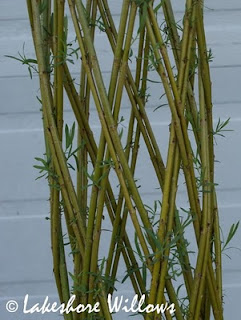This year I chose to decorate my winter planters using willow as the main material.
 The planters at the back door each has 10 large branches of the curly willow, Salix x 'Red Corkscrew Willow' placed in the middle.
The planters at the back door each has 10 large branches of the curly willow, Salix x 'Red Corkscrew Willow' placed in the middle.
To complement the yellow and orange colours I made wreaths of Salix dasyclados and S. sachaliensis 'Sekka' and placed them on the edges of the planters.
 It was easy and I like the look - although I might have added a few, small green branches had the soil not been frozen by the time I started to work on the planters - I was lucky to get the willow rods in place before the soil was too hard.
It was easy and I like the look - although I might have added a few, small green branches had the soil not been frozen by the time I started to work on the planters - I was lucky to get the willow rods in place before the soil was too hard.
The low, black planters at the front door are filled with branches of Salix x 'Flame', a few S. sachaliensis 'Sekka' (Japanese Fantail willow), and "sprigs" of evergreens.
As we do not have Christmas lights on the house, we decided to wrap two very large wreaths and three big stars - made with fresh rods of Salix dasyclados - with strands of clear mini lights and hung them at the front of the house over the holiday. It looked great and I will have to take photos to show next year.
Salix x acutifolia is interesting with a white bloom on the dark wine coloured stems and I used it as decoration on my advendt wreath this year - looking beautiful along with light purple ribbons. As I made a couple of Christmas decorations for the table, I also added a few stems for interest.
It is the last day of 2010 and I wish you all a Happy New Year with good health and lots of laughter.
Words and photos by Lene Rasmussen,Willows.

















































